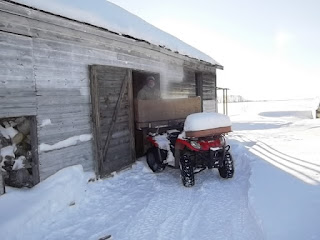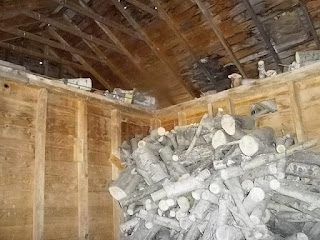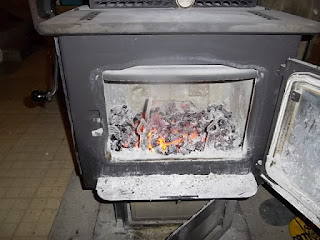This is what one must do in order to survive in January on the
Canadian Prairies if one doesn't use Natural Gas, Oil, or Electricity
to heat their house.

About once a week, after one has chosen what one believes to be a warmer day than the rest, one starts hauling seasoned poplar wood from the the wood shed to the house. The wood has been sitting drying in the shed for about 2 to 3 years, although there are probably some sticks seasoned for as long as 6.
The camera has caught the moisture condensation from our breath as it hits the cold air.
If you look at the top of the partition you can see the wood piled up on other side of the bin--next year's cache, if it doesn't get used before this winter's end.
Those sticks at the very top are dangerous as sometimes they fall down onto the wood gatherer without warning. Ouch!
The nicely blown path had to be made before the wood hauling was even begun.
Note the thermometer on the outside of the house. When the needle is straight up it shows 0 degrees Celsius. In this picture it hovers around minus 24. With the wind chill the temperature today is approaching minus 40 degrees Celsius. I have seen it at 30 degrees Celsius.
There is quite a bit of clunking and banging while the wood is being thrown into this space. No sleeping goes on while this chore is being done.

This is the inside storage area. One can feel the coldness from the frozen wood for about two to three days After that time one may find that a few flies and/or mosquitoes have been awakened from their hiding places in the bark by the warmth of the house. It seems strange to complain of a buzzing mosquito in the bedroom on a frigid January night, but it does happen.
View of the winter wood getting process from the warmth and safety of the house.
In order to get the wood to start on a bed of coals the coals first must be stirred. This involves the use of a bent piece of iron. The assuring sound of this stirring is actually comforting in the middle of a cold winter's night whenever the stove needs refilling. The comfort of hearing this metal clanging sound may be due to the fact that if I am awakened by this sound then it must mean it is not I who is actually out of bed putting the wood in the stove
Depending upon the outside temperature and the dryness of the wood, one has to empty the Ash Pan about every three to five days.
*Please note Bunny Chair for reference below.
The emptied Ash Pan being returned to its place under the Firebox.
The next step in the Home Heating process is the careful selection, measurement and stacking of this varied and often awkward solid fuel.
Removal of storage room door for easy wood access.
Scientific measurement of extra long looking pieces. (Two knot holes from the door jam--too long.)
Note the height of the pile of wood.
Another stick destined for the camping pile.
This process may also involve obligatory splitting of the larger sticks. This process used to be done by hand with an axe for about six to eight hours a week. The purchase of a splitting machine has decreased this time to about one hour a week. The homemade Bunny Chair is optional but does fit into the theme of self sufficiency in spite of the fact that the Splitter is electrical.
And now the final step of Filling the Stove.
The flaming of a piece of wood while one is still loading the stove is a true sign that it is very cold outside.--Note the orange tongue on that piece along the edge.
That piece barely passed the measurement test.
Sometimes it takes the hand of a master to get just the right amount of wood packed in.
Before
After















































No comments:
Post a Comment